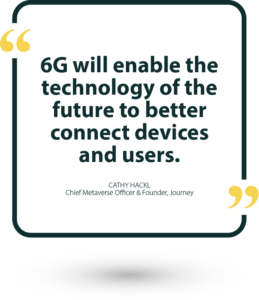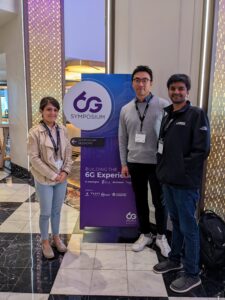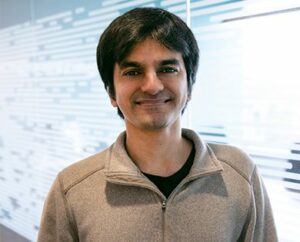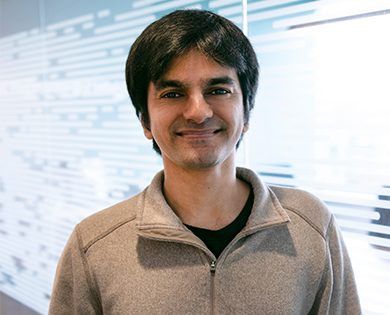The 6G Symposium of Fall 2022 was held on the 11th and 12th of October at the Hotel Washington in Washington, DC. The symposium was organized in partnership with NextG Alliance – of which Ofinno is a founding and full member – together with Interdigital, Northeastern University, and Keysight. Thought leaders across industry, government, and academia participated in the symposium, where ambitious roadmaps and goals were discussed for what a world with 6G would entail.
Three main themes that were prominent throughout the two days were extended reality (XR), satellite and other non-terrestrial networks (NTN), and artificial intelligence and machine learning (AI/ML).
 XR, which broadly includes virtual reality (VR), augmented reality (AR), and mixed reality (MR) is going to be a major application enabled by 6G networks. Milind Kulkarni, Vice President and Head of Wireless Lab at Interdigital, suggested that a large chunk of 6G traffic would include multi-sensory XR and haptics, volumetric streaming, and holographic telepresence-based applications.
XR, which broadly includes virtual reality (VR), augmented reality (AR), and mixed reality (MR) is going to be a major application enabled by 6G networks. Milind Kulkarni, Vice President and Head of Wireless Lab at Interdigital, suggested that a large chunk of 6G traffic would include multi-sensory XR and haptics, volumetric streaming, and holographic telepresence-based applications.
“6G will enable the technology of the future to better connect devices and users,” says Cathy Hackl, who is the Chief Metaverse Officer and Founder at Journey. She predicts that the Metaverse (which includes XR and AR components) economy could potentially reach anywhere between $2.5 trillion to $16 trillion. Current day 5G networks, which could typically handle about 4-5 simultaneous XR links per cell, would need a complete overhaul to serve such XR traffic.
Along with increased speeds, which every generation of telecom networks brings, a crucial goal of 6G networks is to connect the unconnected. 6G networks are expected to serve all areas of the globe, especially those that are currently underserved or unserved. As Thyaga Nandagopal, Directorate of Technology, Innovation and Partnerships (TIP), National Science Foundation, hints, satellite revolution in 6G would change the way cellular systems are going to look like. He highlights a special area of application for 6G communications: mechanized agriculture. This is envisioned to enable fully automated farming, and would require ubiquitous connectivity, which satellite networks can provide with the best bang-for-the-buck. Jennifer Manner, SVP Regulatory Affairs, Echostar, expects that a lot of resistance that currently exists from terrestrial network operators towards adoption of satellite networks will ease as we get closer to 6G, when they start to see the inevitability and value of NTNs.
AI/ML technologies are going to be key enablers in bringing most of the 6G goals to fruition. As Paul Challoner, VP of Network Product Solutions at Ericsson, advocates, 6G networks would be automated to a significant extent, where they can self-heal and self-organize to run themselves using AI/ML aided technologies. The physical layer would also benefit in the form of agile AI-based waveform designs to adapt to diverse communication environments. 6G networks are going to see “AI/ML on steroids” – a phrase that was echoed by several speakers – along the entire pathway, at the radio access network, transport network, core network, and beyond.
In addition to the above three technologies, which are broadly classified under “revolutionary” transformations, “evolutionary” design enhancements in reducing power consumption and transitioning towards zero energy networks, adopting novel waveforms such as orthogonal time frequency space waveforms, shifting the operating spectrum even higher into sub-terahertz and more, and increasing the size of multiple-input multiple-output (MIMO) systems to progress towards a truly massive MIMO architecture, would empower a 6G network to deliver on its promises.
 Ofinno, which has high-utilization rate patent portfolios in 4G LTE and 5G NR domains, is well-positioned to continue excelling with the advent of 6G. With its strong portfolios in fundamental technologies such as MIMO beamforming, operation in unlicensed bands, Internet-of-Things (IoT), mission critical services, and ultra-reliable low latency communication (URLLC), to name a few, and with its growing portfolios in diverse 6G-enabling technologies such as NTN, mmWave and beyond, XR, and sustainable and green communications, among others, Ofinno is in a strong position to remain a leader in technology development in the 6G-era.
Ofinno, which has high-utilization rate patent portfolios in 4G LTE and 5G NR domains, is well-positioned to continue excelling with the advent of 6G. With its strong portfolios in fundamental technologies such as MIMO beamforming, operation in unlicensed bands, Internet-of-Things (IoT), mission critical services, and ultra-reliable low latency communication (URLLC), to name a few, and with its growing portfolios in diverse 6G-enabling technologies such as NTN, mmWave and beyond, XR, and sustainable and green communications, among others, Ofinno is in a strong position to remain a leader in technology development in the 6G-era.
ABOUT THE AUTHOR

Gautham’s research interests include 5G/6G terrestrial and non-terrestrial communications and applications of AI/ML to communication networks. Prior to joining Ofinno, Gautham was an industrial postdoctoral research fellow at The University of British Columbia, Vancouver, BC and Sierra Wireless, Richmond, BC. He has authored dozens of publications in peer-reviewed IEEE journals, conferences, and workshops, including papers that have won multiple IEEE best paper awards. Gautham has also served as an invited reviewer for over 100 journal and conference paper submissions and on the technical program committees of various major IEEE conferences. He holds a PhD from The University of British Columbia, Vancouver, BC, and an MS from the University of Florida, Gainesville, FL, both in electrical and computer engineering.


